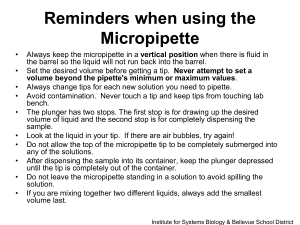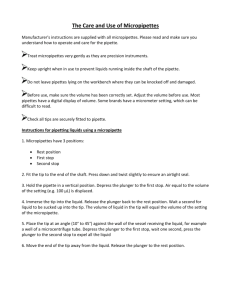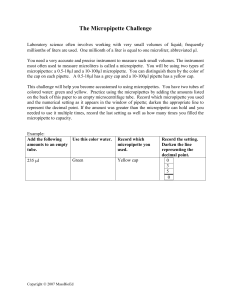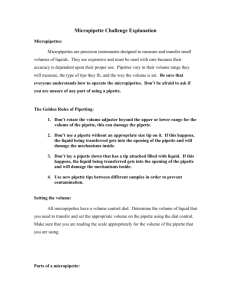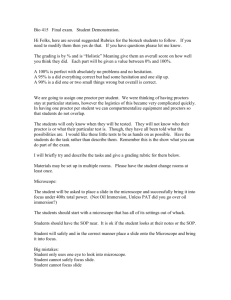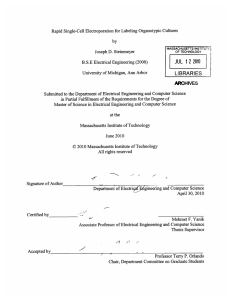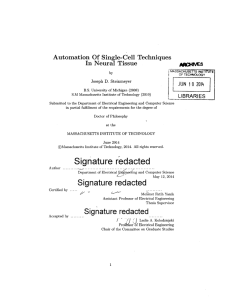2-Power Point
advertisement
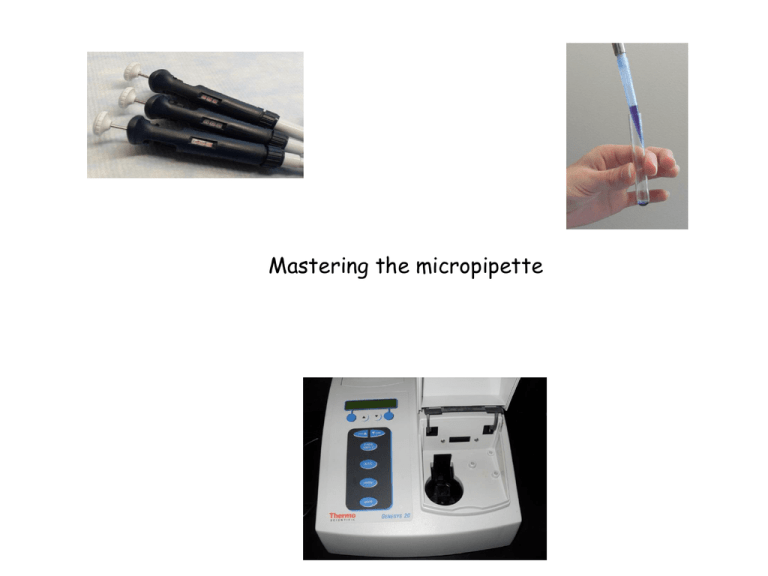
Mastering the micropipette What is a micropipette? How do you use a micropipette? How can I determine if I’m pipetting correctly? Micropipettes work by air displacement 3 kinds of micropipette (various manufacturers) Calibrated to deliver volumes within a certain range P-20 capacity of 20 µL P-200 capacity of 200 µL P-1000 capacity of 1000 µL They’re expensive!! Handle with care Micropipettes are designed to be both accurate and precise A B C D Precise Accurate Precise Inaccurate Imprecise Accurate Imprecise Inaccurate Accurate – the correct volume is delivered Precise – there is minimal variation between the volumes delivered You will do three trials with one micropipette to see how precise your transfers are Your data will be compared with the rest of the class to see how accurate the measurements are What is a micropipette? How do you use a micropipette? How can I determine if I’m pipetting correctly? To begin, attach the appropriate tip to the micropipette P-20 and P-200 use yellow or natural color tips; P-1000s use blue tips Tips have been sterilized Replace the lid after you attach the tip Dispose of used tips in the appropriate waste receptacle! To fill the micropipette, depress the piston to the first stop Depress to the second stop ONLY when expelling the contents Fill stroke Depress the plunger to the first stop Insert the pipette a few millimeters into the solution to be transferred Slowly release the plunger up to the starting position (tip will fill with fluid) For the most accurate transfers, keep the micropipette within 20 degrees of the vertical axis Delivery stroke Place the tip of the micropipette against the wall of the receiving tube Press the plunger to the first stop (a small amount of liquid may remain in the tip) Press the plunger to its full extent to deliver any fluid remaining in the tip What is a micropipette? How do you use a micropipette? How can I determine if I’m pipetting correctly? Ideally, you would weigh a drop of water transferred by the micropipette on an analytical balance, using the specific gravity of water to calculate the volume actually transferred Since we don’t have enough analytical balances, we will use an indirect measure: the absorbance of colored solutions measured with a spectrophotometer Common elements of spectrophotometers cuvette with 1 cm path length Detector Adjustable monochromator allows a single wavelength to pass You will prepare dilutions of a bromophenol blue solution and measure the absorbance of the dilutions at 590 nm Absorbance spectrum of bromophenol blue http://www.wellesley.edu/Chemistry/Chem105manual/Lab10/lab10.html Beer-Lambert Law Predicts a linear relationship between absorbance of a solution and the concentration of a light-absorbing substance in the solution A590 = (a590) x (b) x (c) a b c is a wavelength-dependent proportionality constant is the path length through the absorbing substance (our cuvettes have a standard 1 cm path length) is the concentration of the light absorbing substance Orient the cuvette so the light passes through its 1 cm path Adjust wavelength Set for absorbance readings Light path
